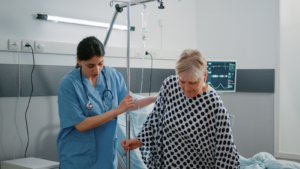Congress Newsletter 2022
Live Report - Best Abstract Competition 2022
The 2022 Euroanaesthesia Best Abstract competition saw a very high standard of research, with all six presentations impressing the judging panel of Barak Cohen (Tel Aviv-Yafo, Israel, chair), Daniela Ionescu (Cluj Napoca, Romania), and Isabell Pekrul (Munich, Germany) then selected our three winners.
All the finalists’ abstracts can be read by clicking here
The first prize of 3,000 Euros was awarded to Dr Ana Arnalich Montiel, who works as a Consultant at the Department of Anesthesia and Intensive Care Medicine of Gregorio Marañón University Hospital in Madrid for her study ‘Maintenance over time of the effect produced by esmolol on the structure of coronary arteries’.
The second prize of 2,000 Euros went to Vittoria Arslan-Carlon (New York at Memorial Sloan Kettering Cancer Center) for her study ‘Pain with movement after hepatic resection: a randomized trial of epidural patient controlled analgesia versus intravenous patient controlled analgesia’; and the third prize of 1,000 Euros was awarded to Dr Åsa Östlund (Karolinska University Hospital in Stockholm, Sweden) for her study ‘prospective study on complications of paediatric midline catheters‘.
The other finalists were Dr Maksym Barsa of Danylo Halytsky Lviv National Medical University, Ukraine; Dr Rokus van den Dool, Amsterdam UMC, Netherlands; and Dr Raquel Okoshi, Hospital de Clínicas de São Bernardo do Campo, Sao Paulo, Brazil.
Here our winner Dr Ana Arnalich Montiel tells us a little about her and her study. She has specialised in Critical Care at Saint George’s Hospital in London, where she completed her PhD. In addition to her work at Gregorio Marañón University Hospital in Madrid, she works as an associate professor at the Medical School of Complutense University in Madrid. She is an examiner of the European Diploma in Anaesthesiology and Intensive Care, and also belongs to the study group “Regenerative Medicine and Cardiovascular System development” at Gregorio Marañon Research Institute.
Q: Congratulations on first prize Ana! How are you feeling?
A: Thank you very much! I really enjoyed the session and I want to congratulate all the other finalists too on their great presentations. I am so happy – but now I must quickly go and catch my plane back to Spain!
Q: Before you go, please could you tell us a little a bit about why you did this study?
A: Vascular remodelling leads to an increase in cardiovascular events and mortality. Consequently, finding a therapy to reverse this situation is highly desirable for our patients. We have previously demonstrated that esmolol produces early regression in vascular remodelling in spontaneously hypertensive rats (SHRs). This was the first time that a drug showed a beneficial effect on coronary artery damage, after a very short interval (48 hours) of therapy. Therefore, we decided to conduct this study to investigate whether vascular remodelling is maintained over time after treatment withdrawal.
Q: And lastly, please tell us about the future implications of the work.
A: In our study, we have demonstrated that the beneficial effect of esmolol on vascular remodelling is maintained over time after treatment is withdrawn. If these findings were demonstrated in humans, esmolol would be the desirable choice to treat hypertension in patients with associated coronary disease, in order to decrease their cardiovascular risk.
Thanks Ana, congratulations and buen viaje!

Winner Dr Ana Arnalich Montiel celebrates with colleagues

Left to right: Our three panel judges with winner Ana Arnalich Montiel, 3rd place Dr Åsa Östlund and 2nd place Vittoria Arslan-Carlon

All six Best Abstract Finalists (standing) with our panel of judges (sitting)
Read More of our special newsletter covering our congress.










